Novel Red Light-Absorbing Organic Dyes Based on Indolo[3,2-b]carbazole as the Donor Applied in Co-Sensitizer-Free Dye-Sensitized Solar Cells
Abstract
1. Introduction
2. Experimental
2.1. Materials and Methods
2.2. Fabrication and Characterization of DSSCs
2.3. Synthesis
- 2-bromo-5,11-bis(2-ethylhexyl)-5,11-dihydroindolo[3,2-b]carbazole (2)
- 5,11-bis(2-ethylhexyl)-2-(4,4,5,5-tetramethyl-1,3,2-dioxaborolan-2-yl)-5,11-dihydroindolo[3,2-b]carbazole (3)
- methyl 4-(7-bromobenzo[c][1,2,5]thiadiazol-4-yl)benzoate (5)
- 5-(7-bromobenzo[c][1,2,5]thiadiazol-4-yl)thiophene-2-carbaldehyde (6)
- 5-(5,11-bis(2-ethylhexyl)-5,11-dihydroindolo[3,2-b]carbazol-2-yl)thiophene-2-carbaldehyde (3a)
- methyl 4-(7-(5,11-bis(2-ethylhexyl)-5,11-dihydroindolo[3,2-b]carbazol-2-yl)benzo[c][1,2,5]thiadiazol-4-yl)benzoate (3b)
- 5-(7-(5,11-bis(2-ethylhexyl)-5,11-dihydroindolo[3,2-b]carbazol-2-yl)benzo[c][1,2,5]thiadiazol-4-yl)thiophene-2-carbaldehyde (3c)
- (E)-3-(5-(5,11-bis(2-ethylhexyl)-5,11-dihydroindolo[3,2-b]carbazol-2-yl)thiophen-2-yl)-2-cyanoacrylic acid (D6)
- methyl 4-(7-(5,11-bis(2-ethylhexyl)-5,11-dihydroindolo[3,2-b]carbazol-2-yl)benzo[c][1,2,5]thiadiazol-4-yl)benzoate (D7)
- (E)-3-(5-(7-(5,11-bis(2-ethylhexyl)-5,11-dihydroindolo[3,2-b]carbazol-2-yl)benzo[c][1,2,5]thiadiazol-4-yl)thiophen-2-yl)-2-cyanoacrylic acid (D8)
3. Results and Discussion
3.1. Photophysical Properties
3.2. Electrochemical Properties
3.3. Theoretical Calculations
3.4. Photovoltaic Properties
3.5. Electrochemical Impedance Spectra (EIS) Analysis
3.6. Stability Study
4. Conclusions
Supplementary Materials
Author Contributions
Funding
Institutional Review Board Statement
Informed Consent Statement
Data Availability Statement
Conflicts of Interest
References
- O’Regan, B.; Grätzel, M. A low-cost, high-efficiency solar cell based on dye-sensitized colloidal TiO2 films. Nature 1991, 353, 737–740. [Google Scholar] [CrossRef]
- Grätzel, M. Dye-sensitized solar cells. J. Photochem. Photobiol. C Photochem. Rev. 2003, 4, 145–153. [Google Scholar] [CrossRef]
- Hagfeldt, A.; Boschloo, G.; Sun, L.; Kloo, L.; Pettersson, H. Dye-Sensitized Solar Cells. Chem. Rev. 2010, 110, 6595–6663. [Google Scholar] [CrossRef]
- Gong, J.; Sumathy, K.; Qiao, Q.; Zhou, Z. Review on dye-sensitized solar cells (DSSCs): Advanced techniques and research trends. Renew. Sustain. Energy Rev. 2017, 68, 234–246. [Google Scholar] [CrossRef]
- Mathew, S.; Yella, A.; Gao, P.; Humphry-Baker, R.; Curchod, B.F.E.; Ashari-Astani, N.; Tavernelli, I.; Rothlisberger, U.; Nazeeruddin, M.K.; Grätzel, M. Dye-sensitized solar cells with 13% efficiency achieved through the molecular engineering of porphyrin sensitizers. Nat. Chem. 2014, 6, 242–247. [Google Scholar] [CrossRef]
- Nazeeruddin, M.K.; Kay, A.; Rodicio, I.; Humphry-Baker, R.; Mueller, E.; Liska, P.; Vlachopoulos, N.; Graetzel, M. Conversion of light to electricity by cis-X2bis(2,2′-bipyridyl-4,4′-dicarboxylate)ruthenium(II) charge-transfer sensitizers (X = Cl-, Br-, I-, CN-, and SCN-) on nanocrystalline titanium dioxide electrodes. J. Am. Chem. Soc. 1993, 115, 6382–6390. [Google Scholar] [CrossRef]
- Mishra, A.; Fischer, M.K.R.; Büuerle, P. Metal-Free organic dyes for dye-Sensitized solar cells: From structure: Property relationships to design rules. Angew. Chem. Int. Ed. 2009, 48, 2474–2499. [Google Scholar] [CrossRef]
- Ooyama, Y.; Harima, Y. Molecular designs and syntheses of organic dyes for dye-sensitized solar cells. Eur. J. Org. Chem. 2009, 2903–2934. [Google Scholar] [CrossRef]
- Kakiage, K.; Aoyama, Y.; Yano, T.; Otsuka, T.; Kyomen, T.; Unno, M.; Hanaya, M. An achievement of over 12 percent efficiency in an organic dye-sensitized solar cell. Chem. Commun. 2014, 50, 6379–6381. [Google Scholar] [CrossRef] [PubMed]
- Chaurasia, S.; Liang, C.-J.; Yen, Y.-S.; Lin, J.T. Sensitizers with rigidified-aromatics as the conjugated spacers for dye-sensitized solar cells. J. Mater. Chem. C 2015, 3, 9765–9780. [Google Scholar] [CrossRef]
- Zhang, G.; Bai, Y.; Li, R.; Shi, D.; Wenger, S.; Zakeeruddin, S.M.; Grätzel, M.; Wang, P. Employ a bisthienothiophene linker to construct an organic chromophore for efficient and stable dye-sensitized solar cells. Energy Environ. Sci. 2009, 2, 92–95. [Google Scholar] [CrossRef]
- Mariotti, N.; Bonomo, M.; Fagiolari, L.; Barbero, N.; Gerbaldi, C.; Bella, F.; Barolo, C. Recent advances in eco-friendly and cost-effective materials towards sustainable dye-sensitized solar cells. Green Chem. 2020, 22, 7168–7218. [Google Scholar] [CrossRef]
- Babu, D.D.; Naik, P.; Keremane, K.S. A simple D-A-π-A configured carbazole based dye as an active photo-sensitizer: A comparative investigation on different parameters of cell. J. Mol. Liquids 2020, 310, 113189. [Google Scholar] [CrossRef]
- An, J.; Yang, X.; Cai, B.; Zhang, L.; Yang, K.; Yu, Z.; Wang, X.; Hagfeldt, A.; Sun, L. Fine-Tuning by Triple Bond of Carbazole Derivative Dyes to Obtain High Efficiency for Dye-Sensitized Solar Cells with Copper Electrolyte. ACS Appl. Mater. Interfaces 2020, 12, 46397–46405. [Google Scholar] [CrossRef]
- Alhorani, S.; Kumar, S.; Genwa, M.; Meena, P.L. Review of latest efficient sensitizer in dye-sensitized solar cells. In Proceedings of the Dae Solid State Physics Symposium 2019, Jodhpur, India, 18–22 December 2019. [Google Scholar]
- Jung, I.H.; Kim, J.-H.; Nam, S.Y.; Lee, C.; Hwang, D.-H.; Yoon, S.C. Development of New Photovoltaic Conjugated Polymers Based on Di(1-benzothieno)[3,2-b:2′,3′-d]pyrrole: Benzene Ring Extension Strategy for Improving Open-Circuit Voltage. Macromolecules 2015, 48, 5213–5221. [Google Scholar] [CrossRef]
- Jung, I.H.; Kim, J.-H.; Nam, S.Y.; Lee, C.; Hwang, D.-H.; Yoon, S.C. A di(1-benzothieno)[3,2-b:2′,3′-d]pyrrole and isoindigo-based electron donating conjugated polymer for efficient organic photovoltaics. J. Mater. Chem. C 2016, 4, 663–667. [Google Scholar] [CrossRef]
- Zeng, W.D.; Cao, Y.M.; Bai, Y.; Wang, Y.H.; Shi, Y.S.; Zhang, M.; Wang, F.F.; Pan, C.Y.; Wang, P. Efficient Dye-Sensitized Solar Cells with an Organic Photosensitizer Featuring Orderly Conjugated Ethylenedioxythiophene and Dithienosilole Blocks. Chem. Mater. 2010, 22, 1915–1925. [Google Scholar] [CrossRef]
- Ni, J.-S.; Yen, Y.-C.; Lin, J.T. Organic Dyes with a Fused Segment Comprising Benzotriazole and Thieno[3,2-b]pyrrole Entities as the Conjugated Spacer for High Performance Dye-Sensitized Solar Cells. Chem. Commun. 2015, 51, 17080–17083. [Google Scholar] [CrossRef]
- Wu, Y.; Li, Y.; Gardner, S.; Ong, B.S. Indolo[3,2-b]carbazole-based thin-film transistors with high mobility and stability. J. Am. Chem. Soc. 2005, 127, 614–618. [Google Scholar] [CrossRef]
- Wu, Y.; Zhu, W. Organic sensitizers from D–π–A to D–A–π–A: Effect of the internal electron-withdrawing units on molecular absorption, energy levels and photovoltaic performances. Chem. Soc. Rev. 2013, 42, 2039–2058. [Google Scholar] [CrossRef]
- Yen, Y.S.; Chou, H.H.; Chen, Y.C.; Hsu, C.Y.; Lin, J.T. Recent developments in molecule-based organic materials for dye-sensitized solar cells. J. Mater. Chem. 2012, 22, 8734–8747. [Google Scholar] [CrossRef]
- Xiao, Z.; Di, Y.; Tan, Z.; Cheng, X.; Chen, B.; Feng, J. Efficient organic dyes based on perpendicular 6,12-diphenyl substituted indolo[3,2-: B] carbazole donor. Photochem. Photobiol. Sci. 2016, 15, 1514–1523. [Google Scholar] [CrossRef] [PubMed]
- Xiao, Z.; Chen, B.; Di, Y.; Wang, H.; Cheng, X.; Feng, J. Effect of substitution position on photoelectronic properties of indolo[3,2-b]carbazole-based metal-free organic dyes. Sol. Energy 2018, 173, 825–833. [Google Scholar] [CrossRef]
- Yao, Z.; Wu, H.; Li, Y.; Wang, J.; Zhang, J.; Zhang, M.; Guo, Y.; Wang, P. Dithienopicenocarbazole as the kernel module of low-energy-gap organic dyes for efficient conversion of sunlight to electricity. Energy Environ. Sci. 2015, 8, 3192–3197. [Google Scholar] [CrossRef]
- Wang, E.; Yao, Z.; Zhang, Y.; Shao, G.; Zhang, M.; Wang, P. Significant Influences of Elaborately Modulating Electron Donors on Light Absorption and Multichannel Charge-Transfer Dynamics for 4-(Benzo[c][1,2,5]thiadiazol-4-ylethynyl)benzoic Acid Dyes. ACS Appl. Mater. Interfaces 2016, 8, 18292–18300. [Google Scholar] [CrossRef] [PubMed]
- Cabau, L.; Vijay Kumar, C.; Moncho, A.; Clifford, J.N.; López, N.; Palomares, E. A single atom change “switches-on” the solar-toenergy conversion efficiency of Zn-porphyrin based dye sensitized solar cells to 10.5%. Energy Environ. Sci. 2015, 8, 1368–1375. [Google Scholar] [CrossRef]
- Xie, Y.; Tang, Y.; Wu, W.; Wang, Y.; Liu, J.; Li, X.; Tian, H.; Zhu, W.H. Porphyrin Cosensitization for a Photovoltaic Efficiency of 11.5%: A Record for Non-Ruthenium Solar Cells Based on Iodine Electrolyte. J. Am. Chem. Soc. 2015, 137, 14055–14058. [Google Scholar] [CrossRef] [PubMed]
- Zhang, H.; Chen, Z.E.; Hu, J.; Hong, Y. Novel rod-shaped organic sensitizers for liquid and quasi-solid-state dye-sensitized solar cells. Electrochim. Acta 2019, 295, 934–941. [Google Scholar] [CrossRef]
- Huang, Z.-S.; Feng, H.-L.; Zang, X.-F.; Iqbal, Z.; Zeng, H.; Kuang, D.-B.; Wang, L.; Meier, H.; Cao, D. Dithienopyrrolobenzothiadiazole-based organic dyes for efficient dye-sensitized solar cells. J. Mater. Chem. A 2014, 2, 15365–15376. [Google Scholar] [CrossRef]
- Zang, X.-F.; Huang, Z.-S.; Wu, H.-L.; Iqbal, Z.; Wang, L.; Meier, H.; Cao, D. Molecular design of the diketopyrrolopyrrole-based dyes with varied donor units for efficient dye-sensitized solar cells. J. Power Sources 2014, 271, 455–464. [Google Scholar] [CrossRef]
- Zhang, H.; Fan, J.; Iqbal, Z.; Kuang, D.-B.; Wang, L.; Meier, H.; Cao, D. Novel dithieno[3,2-b:2′,3′-d]pyrrole-based organic dyes with high molar extinction coefficient for dye-sensitized solar cells. Org. Electron. 2013, 14, 2071–2081. [Google Scholar] [CrossRef]
- Li, R.; Liu, J.; Cai, N.; Zhang, M.; Wang, P. Synchronously reduced surface states, charge recombination, and light absorption length for high-performance organic dye-sensitized solar cells. J. Phys. Chem. B 2010, 114, 4461–4464. [Google Scholar] [CrossRef]
- Kitamura, T.; Ikeda, M.; Shigaki, K.; Inoue, T.; Anderson, N.A.; Ai, X.; Lian, T.; Yanagida, S. Phenyl-Conjugated Oligoene Sensitizers for TiO2 Solar Cells. Chem. Mater. 2004, 16, 1806–1812. [Google Scholar] [CrossRef]
- Qian, X.; Zhu, Y.-Z.; Chang, W.-Y.; Song, J.; Pan, B.; Lu, L.; Gao, H.-H.; Zheng, J.-Y. Benzo[a]carbazole-Based Donor−π–Acceptor Type Organic Dyes for Highly Efficient Dye-Sensitized Solar Cells. ACS Appl. Mater. Interfaces 2015, 7, 9015–9022. [Google Scholar] [CrossRef] [PubMed]
- Gao, X.; Li, Y.; Yu, L.; Hou, F.; Zhu, T.; Bao, X.; Li, F.; Sun, M.; Yang, R. The regulation of π-bridge of indacenodithiophene-based donor-π-acceptor conjugated polymers toward efficient polymer solar cells. Dyes Pigments 2019, 162, 43–51. [Google Scholar] [CrossRef]
- Zhong, Y.; Liu, D.; Zhang, K.; Li, Y.; Sun, M.; Yu, L.; Li, F.; Liu, H.; Yang, R. Modifying the morphology via employing rigid phenyl side chains achieves efficient nonfullerene polymer solar cells. J. Polym. Sci. Part A Polym. Chem. 2018, 56, 2762–2770. [Google Scholar] [CrossRef]
- Wu, H.; Huang, Z.; Hua, T.; Liao, C.; Meier, H.; Tang, H.; Wang, L.; Cao, D.J.D. Metal-free organic dyes with di(1-benzothieno)[3,2-b:2′,3′-d]pyrrole as a donor for efficient dye-sensitized solar cells: Effect of mono- and bi-anchors on photovoltaic performance. Dyes Pigments 2019, 165, 103–111. [Google Scholar] [CrossRef]
- Vollbrecht, J.; Lee, J.; Ko, S.-J.; Brus, V.V.; Karki, A.; Le, W.; Seifrid, M.; Ford, M.J.; Cho, K.; Bazan, G.C.; et al. Design of narrow bandgap non-fullerene acceptors for photovoltaic applications and investigation of non-geminate recombination dynamics. J. Mater. Chem. C 2020, 8, 15175–15182. [Google Scholar] [CrossRef]
- Lee, J.; Singh, R. Competitive role between conformational lock and steric hindrance in D-A copolymers containing 1,4-bis(thieno[3,2-b]thiophen-2-yl)benzene unit. Dyes Pigments 2020, 181, 108540. [Google Scholar] [CrossRef]
- Fang, J.-K.; Hu, X.; Xu, M.; Wang, H.; Zhang, Y.; Jin, C.; Zhong, X. Molecular Engineering of Efficient Organic Sensitizers Containing Diyne-Bridge for Dye-Sensitized Solar Cells. Electrochim. Acta 2017, 253, 572–580. [Google Scholar] [CrossRef]
- Huang, Z.S.; Zang, X.F.; Hua, T.; Wang, L.; Meier, H.; Cao, D. 2,3-Dipentyldithieno[3,2-f:2′,3′-h]quinoxaline-based organic dyes for efficient dye-sensitized solar cells: Effect of π-bridges and electron donors on solar cell performance. ACS Appl. Mater. Interfaces 2015, 7, 20418–20429. [Google Scholar] [CrossRef] [PubMed]
- Wu, Y.; Zhang, Q.; Li, J.; Tian, X.; Li, D.; Lu, X.; Xu, B.; Wu, Y.; Guo, K. Regulation of dithiafulvene-based molecular shape and aggregation on TiO2 for high efficiency dye-sensitized solar cells. J. Mater. Chem. C 2019, 7, 1974–1981. [Google Scholar] [CrossRef]
- Pei, K.; Wu, Y.; Islam, A.; Zhang, Q.; Han, L.; Tian, H.; Zhu, W. Constructing high-efficiency D-A-pi-A-featured solar cell sensitizers: A promising building block of 2,3-diphenylquinoxaline for antiaggregation and photostability. ACS Appl. Mater. Interfaces 2013, 5, 4986–4995. [Google Scholar] [CrossRef] [PubMed]
- Huang, Z.-S.; Hua, T.; Tian, J.; Wang, L.; Meier, H.; Cao, D. Dithienopyrrolobenzotriazole-based organic dyes with high molar extinction coefficient for efficient dye-sensitized solar cells. Dyes Pigments 2016, 125, 229–240. [Google Scholar] [CrossRef]

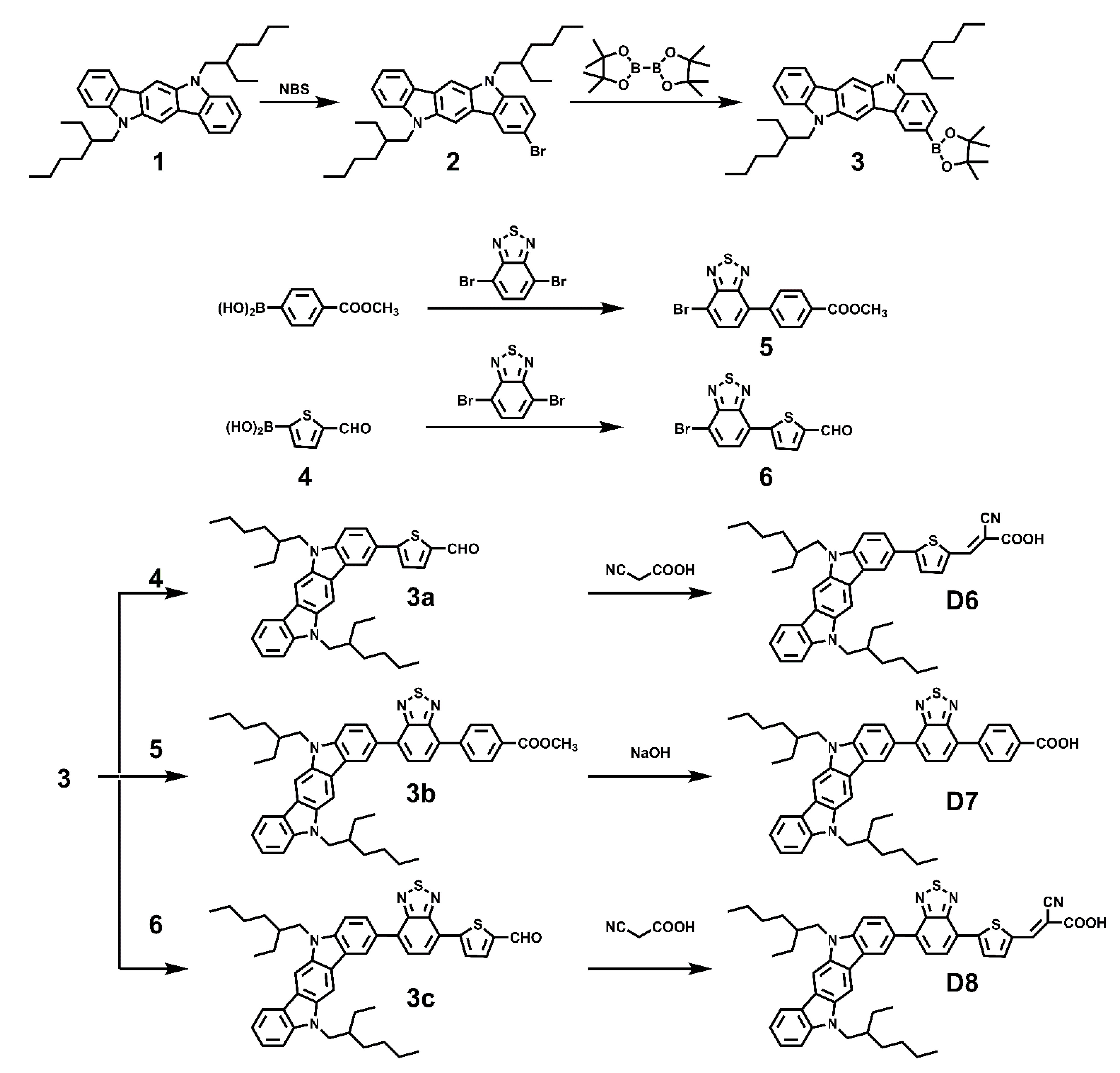
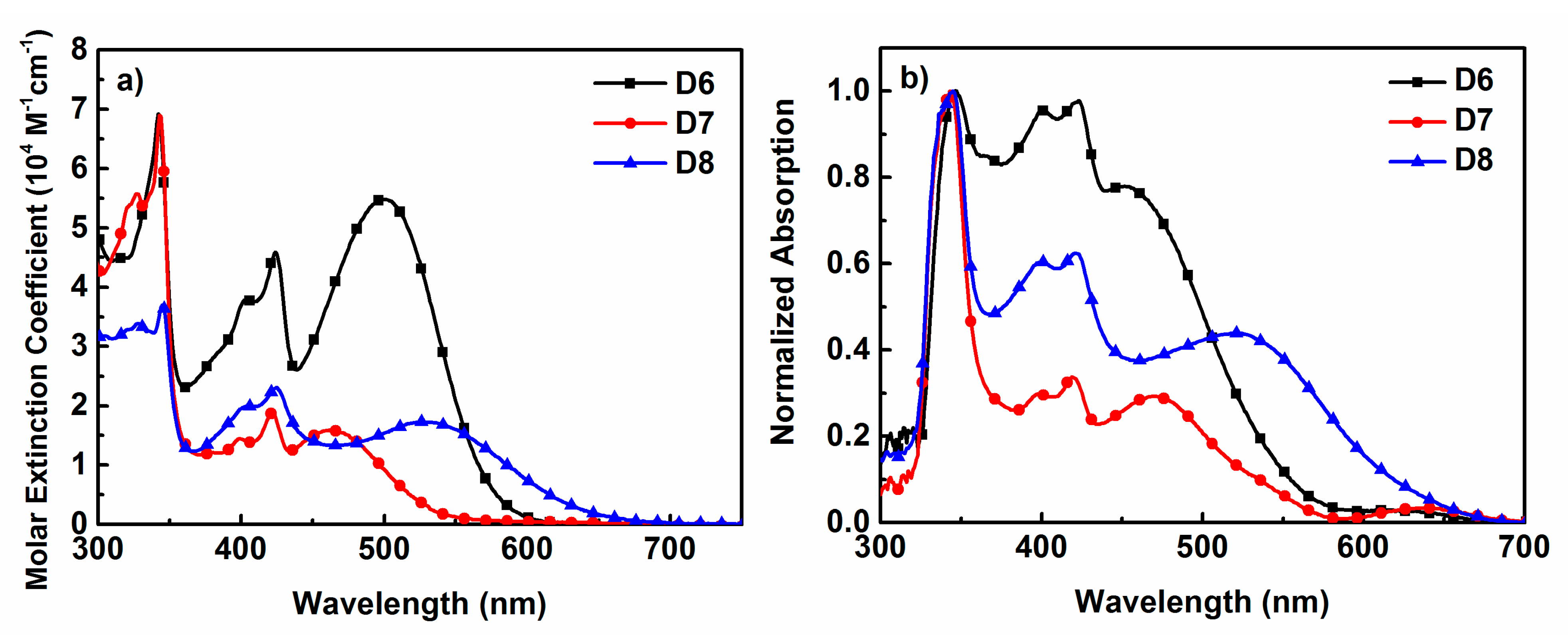
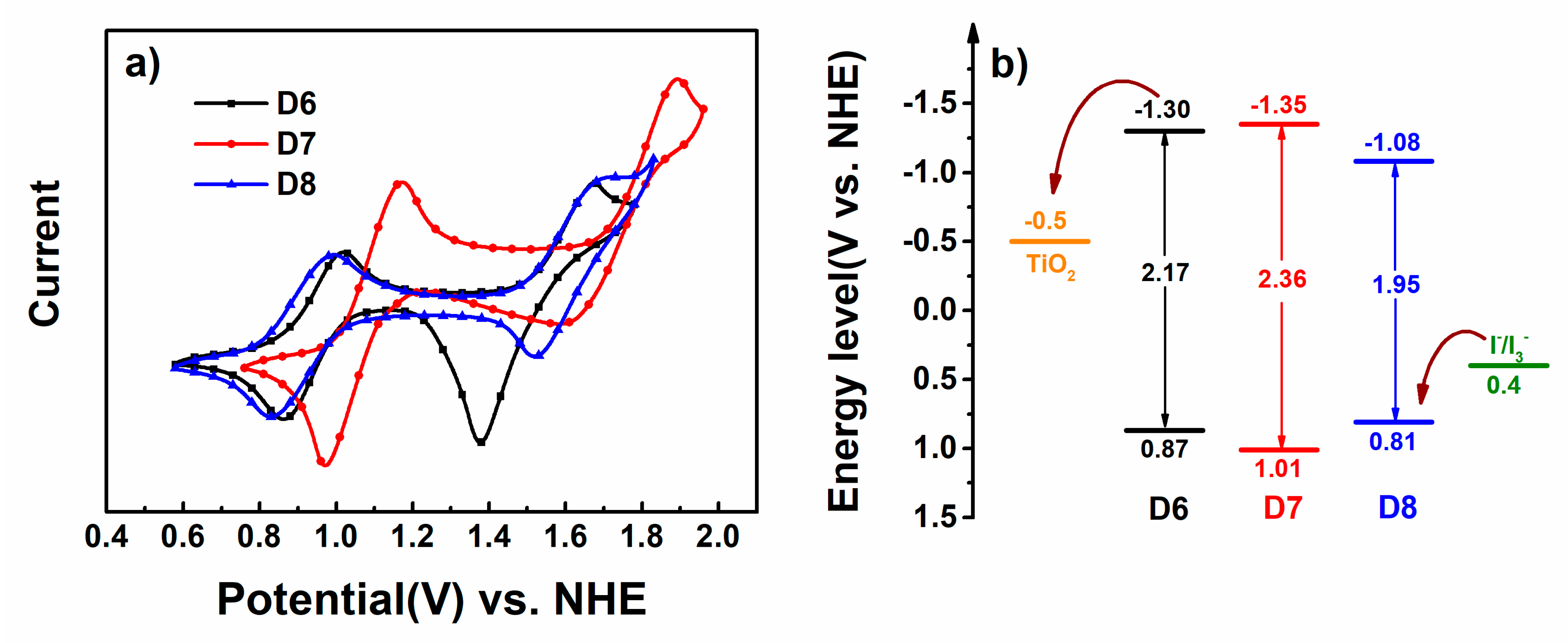
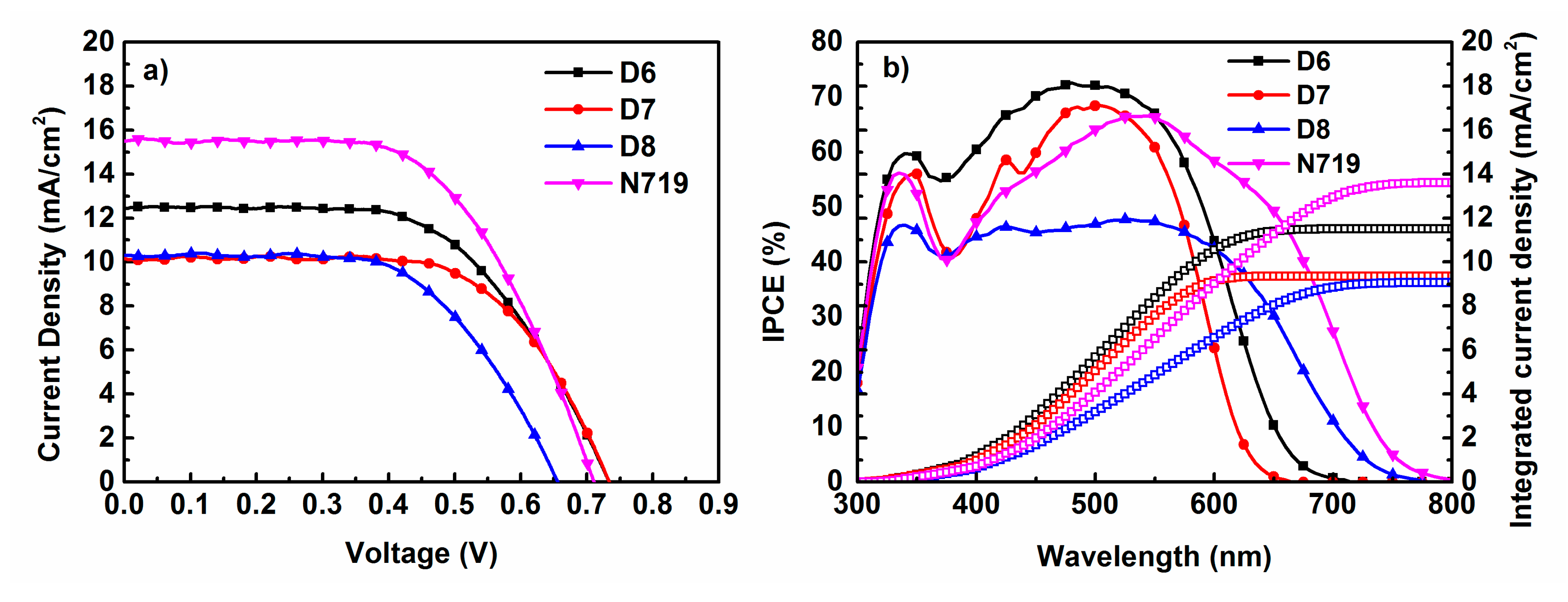
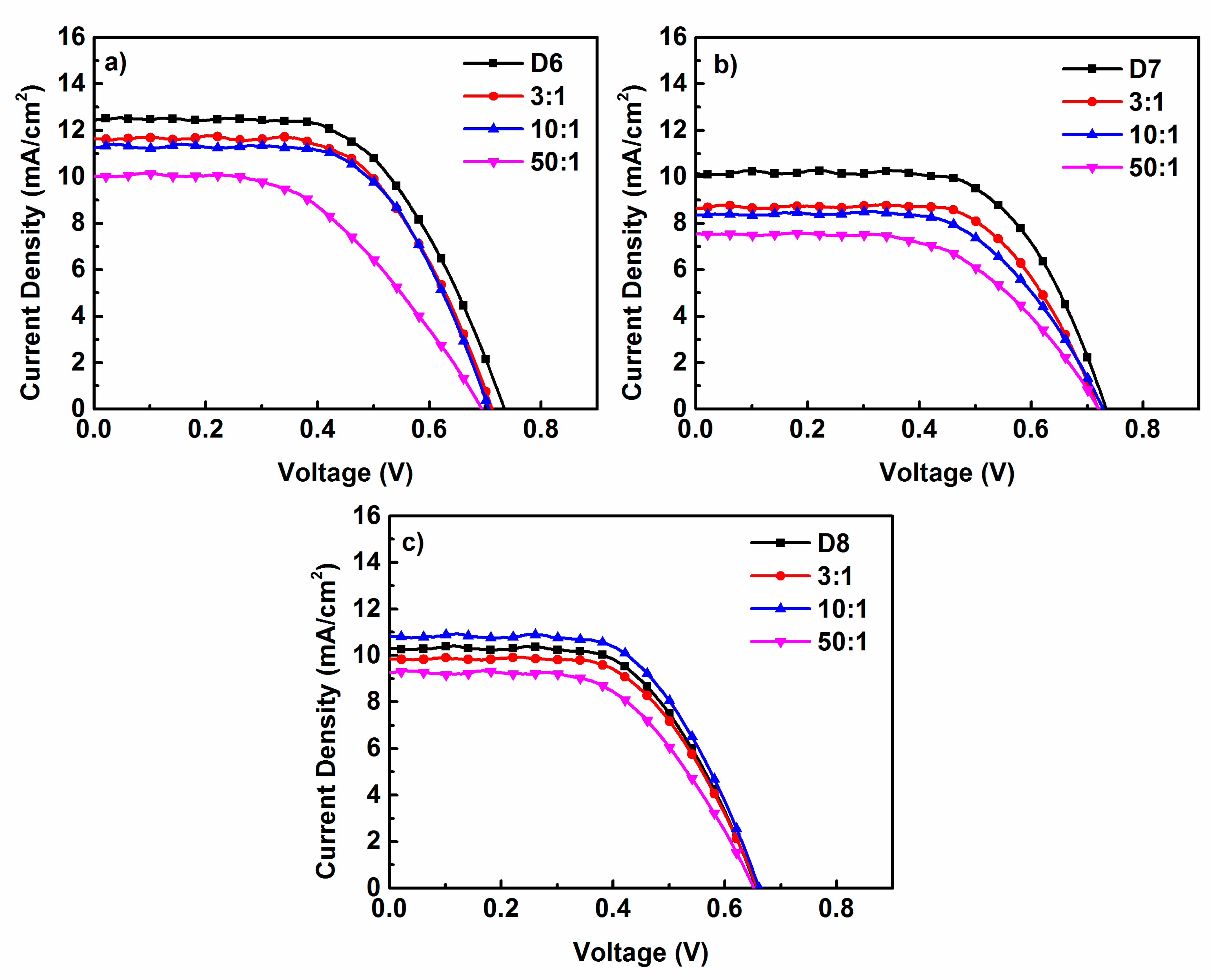
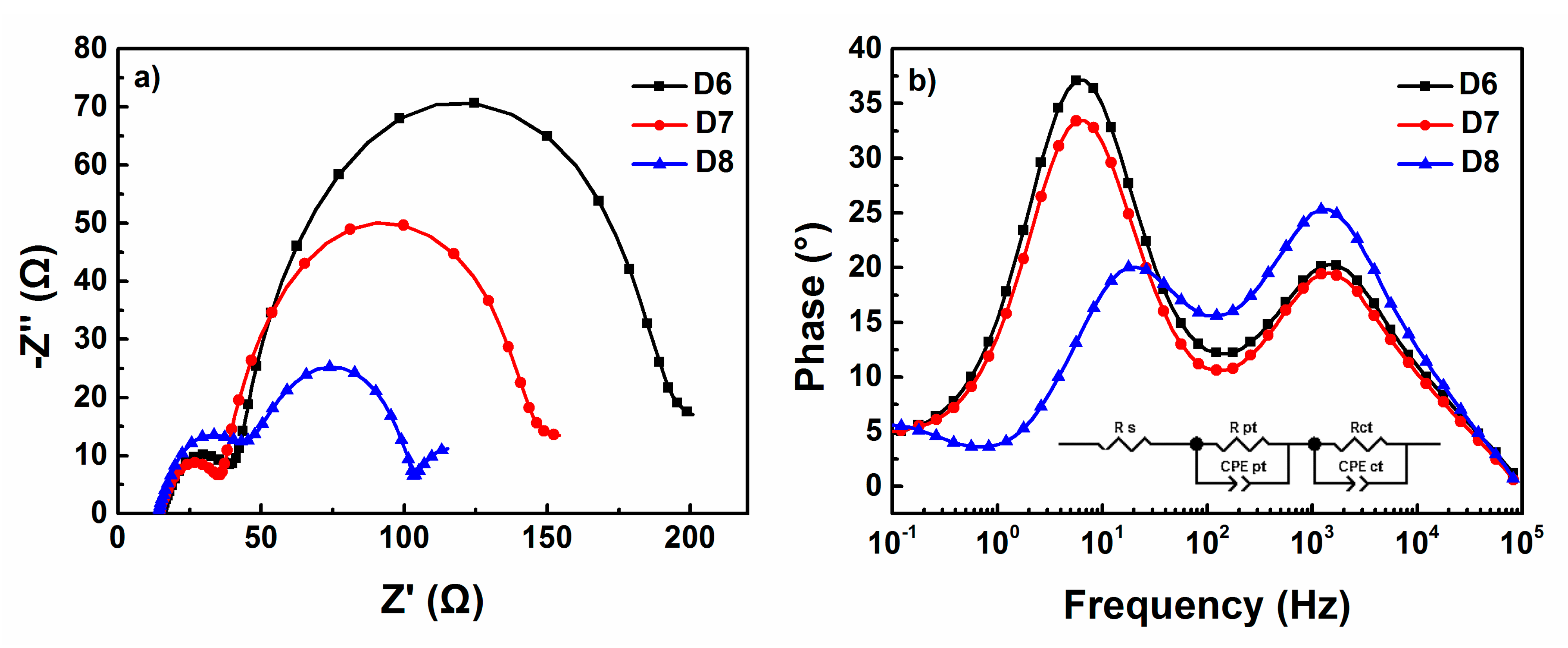
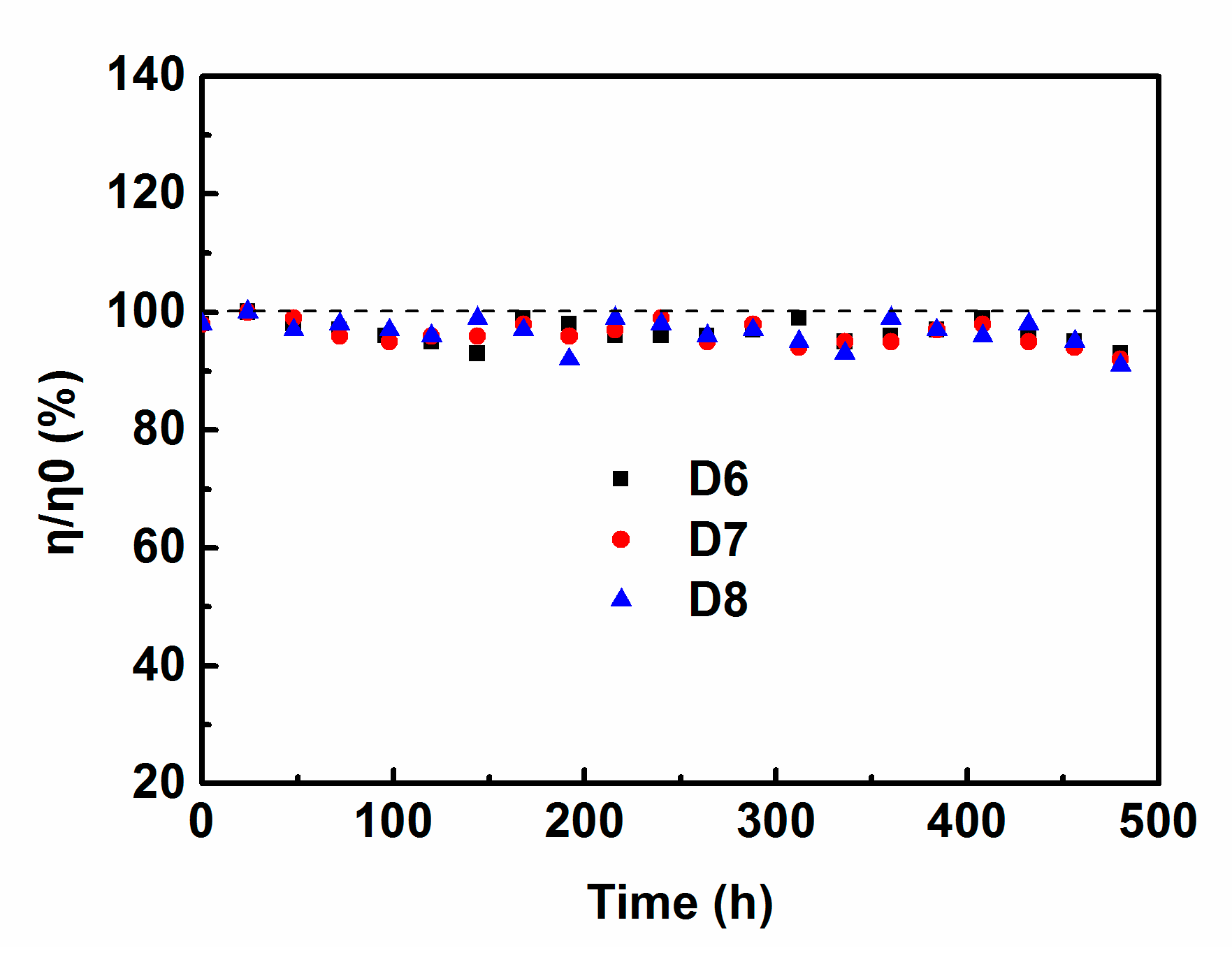
| Dye | (λmax [a] nm/ε [a] M−1cm−1) | E0-0 [b] (eV) | Eox [c] (V) | Ered [d] (V) | Ginj[e] (eV) | Greg[f] (eV) |
|---|---|---|---|---|---|---|
| D6 | 404 (3.79 × 104), 424 (4.59 × 104), 500 (5.48 × 104) | 2.17 | 0.87 | −1.30 | −0.80 | −0.47 |
| D7 | 399 (1.44 × 104), 421 (1.87 × 104), 463 (1.58 × 104) | 2.36 | 1.01 | −1.35 | −0.85 | −0.61 |
| D8 | 404 (1.99 × 104), 425 (2.31 × 104), 529 (1.73 × 104) | 1.95 | 0.81 | −1.08 | −0.58 | −0.41 |
| Dyes | Optimized Structure | HOMO | LUMO |
|---|---|---|---|
| D6 | 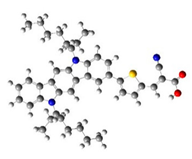 | 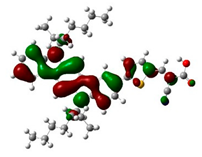 | 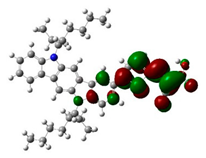 |
| D7 | 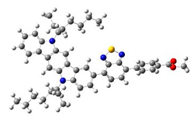 | 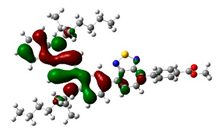 | 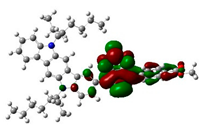 |
| D8 | 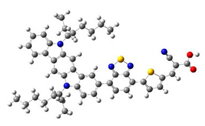 | 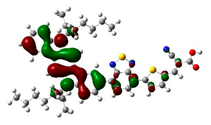 | 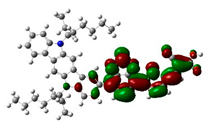 |
| Dye | Side View | Dihedral Angle |
|---|---|---|
| D6 |  | 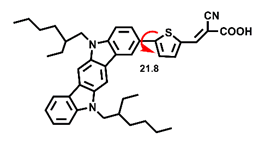 |
| D7 | 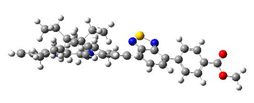 | 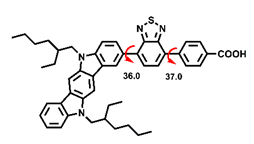 |
| D8 |  | 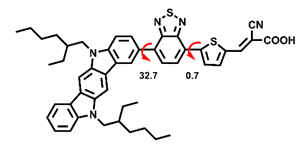 |
| Dyes | CDCA:Dyes | Jsc/mA cm−2 | Voc/mV | FF | PCE/% |
|---|---|---|---|---|---|
| D6 | 0:1 | 12.55 | 745 | 0.59 | 5.41 |
| 3:1 | 11.55 | 722 | 0.59 | 5.00 | |
| 10:1 | 11.23 | 718 | 0.61 | 4.90 | |
| 50:1 | 10.09 | 712 | 0.49 | 3.50 | |
| D7 | 0:1 | 10.16 | 744 | 0.66 | 5.01 |
| 3:1 | 8.65 | 727 | 0.64 | 4.05 | |
| 10:1 | 8.32 | 738 | 0.60 | 3.70 | |
| 50:1 | 7.50 | 730 | 0.56 | 3.09 | |
| D8 | 0:1 | 10.38 | 662 | 0.59 | 4.03 |
| 3:1 | 9.87 | 664 | 0.59 | 3.85 | |
| 10:1 | 10.90 | 671 | 0.59 | 4.28 | |
| 50:1 | 9.20 | 659 | 0.56 | 3.40 | |
| N719 | 0 | 15.40 | 720 | 0.59 | 6.50 |
Publisher’s Note: MDPI stays neutral with regard to jurisdictional claims in published maps and institutional affiliations. |
© 2021 by the authors. Licensee MDPI, Basel, Switzerland. This article is an open access article distributed under the terms and conditions of the Creative Commons Attribution (CC BY) license (https://creativecommons.org/licenses/by/4.0/).
Share and Cite
Xiao, Z.; Chen, B.; Cheng, X. Novel Red Light-Absorbing Organic Dyes Based on Indolo[3,2-b]carbazole as the Donor Applied in Co-Sensitizer-Free Dye-Sensitized Solar Cells. Materials 2021, 14, 1716. https://doi.org/10.3390/ma14071716
Xiao Z, Chen B, Cheng X. Novel Red Light-Absorbing Organic Dyes Based on Indolo[3,2-b]carbazole as the Donor Applied in Co-Sensitizer-Free Dye-Sensitized Solar Cells. Materials. 2021; 14(7):1716. https://doi.org/10.3390/ma14071716
Chicago/Turabian StyleXiao, Zhanhai, Bing Chen, and Xudong Cheng. 2021. "Novel Red Light-Absorbing Organic Dyes Based on Indolo[3,2-b]carbazole as the Donor Applied in Co-Sensitizer-Free Dye-Sensitized Solar Cells" Materials 14, no. 7: 1716. https://doi.org/10.3390/ma14071716
APA StyleXiao, Z., Chen, B., & Cheng, X. (2021). Novel Red Light-Absorbing Organic Dyes Based on Indolo[3,2-b]carbazole as the Donor Applied in Co-Sensitizer-Free Dye-Sensitized Solar Cells. Materials, 14(7), 1716. https://doi.org/10.3390/ma14071716






